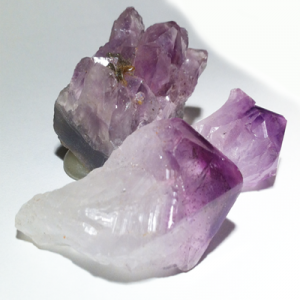Quartz Family
Quartz is one of the most common minerals on Earth. It is composed of silicon and oxygen, the two most abundant elements in the crust of the Earth. Quartz comes in many colors including purple/violet (Amethyst); yellow and purple (Ametrine); yellow/orange (Citrine); pink (Rose Quartz); brown (Smoky Quartz); green (Prasiolite) and colorless (Rock Crystal). The various colors are due to trace elements added to the basic Silicon Dioxide formula. Quartz also has many attractive and collectible inclusions (see below) created by the addition of other minerals such as Actinolite, Gilalite, Lepidocrocite, Pyrite, Rutile, Tourmaline and many others. Quartz cats eyes and stars are also available and are created by the presence of fine asbestos or rutile fibers. Quartz gems have been faceted in enormous sizes. The Smithsonian Institute (SI) has a perfect sphere of flawless Burmese Rock Crystal that is 12.75 inch in diameter and weighs 107 pounds. SI also has a 7000-carat faceted Quartz, a 2258 karat Brazilian Citrine, a 4500 karat Smoky Quartz and a 1362 karat Brazilian Amethyst!
| Chemical Formula: | SiO2 |
| Silicon Dioxide | |
| Molecular Weight: | 60.08 gm |
| Composition: | Silicon | 46.74 % | Be | 100.00 % | SiO2 |
| Oxygen | 53.26 % | O | |||
| 100.00 % | 100.00 % | = TOTAL OXIDE |
| Crystallography: | Trigonal – Trapezohedal |
| Crystal Habit: | Widely variable; but typically long prismatic with steep pyramidal terminations, but may be short prismatic to nearly bipyramidal; fibrous (Agate & Chalcedony) |
| Twinning: | Very common, penetration twins on the Dauphiné law, about [0001], and the Brazil law, with [1120] as contact plane; contact twins on the Japan law, with [1122] as contact plane, may be repeated; and several other laws. |
| Cleavage: | [0110] Indistinct |
| Fracture: | Conchoidal |
| Tenacity: | Brittle, tough when massive |
| Moh’s Hardness: | 7.0 |
| Density: | 2.60 – 2.65 (g/cm3) |
| Luminescence: | Fluorescent; Shortwave UV = yellow-orange, Longwave UV = yellow-orange. May be Triboluminescent |
| Radioactivity: | Not Radioactive |
| Other: | Piezoelectric and Pyroelectric and may be Triboluminescent |
| Color: | Colorless, white, gray, and many shades of violet, purple, yellow, orange, red, brown, pink, green, blue and black |
| Transparency: | Transparent to nearly Opaque |
| Luster: | Vitreous, waxy to dull when massive |
| Refractive Index: | 1.543 – 1.554 Uniaxial ( + ) |
| Birefringence: | 0.0090 |
| Dispersion: | 0.013 (low) |
| Pleochroism: | Quartz: none; Amethyst: weak; Citrine: weak; Rose Quartz: strong |


